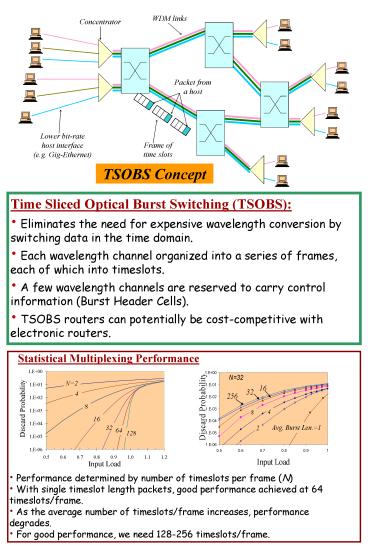Frame of - PowerPoint PPT Presentation
1 / 4
Title:
Frame of
Description:
Each wavelength channel organized into a series of frames, each of which into timeslots. ... Performance determined by number of timeslots per frame (N) ... – PowerPoint PPT presentation
Number of Views:54
Avg rating:3.0/5.0
Title: Frame of
1
WDM links
Concentrator
Packet from a host
Lower bit-rate host interface (e.g. Gig-Ethernet)
Frame of time slots
TSOBS Concept
- Time Sliced Optical Burst Switching (TSOBS)
- Eliminates the need for expensive wavelength
conversion by switching data in the time domain. - Each wavelength channel organized into a series
of frames, each of which into timeslots. - A few wavelength channels are reserved to carry
control information (Burst Header Cells). - TSOBS routers can potentially be
cost-competitive with electronic routers.
Statistical Multiplexing Performance
- Performance determined by number of timeslots
per frame (N) - With single timeslot length packets, good
performance achieved at 64 timeslots/frame. - As the average number of timeslots/frame
increases, performance degrades. - For good performance, we need 128-256
timeslots/frame.
2
TSOBS Router Design
OTSI Design
- TSOBS Router Design
- Each wavelength channel is demultiplexed and
switched independently. - Uses high-speed crossbars to switch data into
timeslots. - Each router is equipped with a few regeneration
ports to regenerate signals as necessary. - OTSIs use fiber delay lines to provide the time
domain switching. - OTSIs use WDM for the delay lines, thus sharing
the cost of fiber among the wavelengths. - SYNCs synchronize data to a common timing
reference using a structure similar to OTSIs.
Optical Time Slot Interchanger Design
- Nonblocking OTSIs provide the best performance,
however they are significantly more expensive. - Key performance criteria
- Num. of switching operations per timeslot
- Scheduling complexity of timeslots
- Number of delay lines (size of crossbar)
- Natural choice of delay values for blocking
OTSIs 1, 2, 3,, N/2 timeslots. - Blocking OTSIs give good performance using at
most 3 switching operations for most timeslots.
1 Time Sliced Optical Burst Switching,
J.Ramamirtham and J. Turner, Proceedings of
INFOCOM 2003, April 2003.
3
Component Cost Requirements
- Cost/Gbps changes linearly with cost of
crossbars and multiplexors. - Cost of the system scales linearly with number
of wavelengths. - The cost of the fiber is not a big factor for a
large number of wavelengths. - Above estimates are for a system with 16
input/output fibers, 128 wavelengths per fiber,
and 128 timeslots per frame.
1 µs Timeslot
Synchronizer Design
- A timeslot has a guard time with a minimum guard
time for switching operations. - For a system with 1 µs timeslots each having 100
ns guard times and 20 ns minimum guard time, the
900 ns long data can be placed anywhere in a 960
ns period.
Minimum guard time20ns
960 ns
Data900ns
- Two parameters affect the cost
- Precision difference between successive delay
values (60 ns) - Range maximum delay it provides
- By operating with links synchronized to timeslot
boundaries instead of frame boundaries, the range
can be reduced. - For a network with 1 µs timeslots each having 100
ns guard times, the synchronizer can be operated
with a precision-to-range ratio of 110.
Incoming Signals
Passive Coupler
Optical Crossbar
Optical Crossbar
Optical Crossbar
- Two switching stages delay lines of 1, 2,,
??S?-1 followed by ??S?, 2??S?,, (??S? -1) ??S?. - Two switching operations needed.
- Two crossbars of size ??S? x ??S?
- Good for moderate number of delay values.
- One delay line for each delay value, 1, 2,, S
(S range-precision ratio) - One switching operation needed.
- Good for small number of delay values.
Department of Computer Science And Engineering
4
Design Issues for Time Sliced Optical Burst
Routers
Jeyashankher Ramamirtham, Jonathan Turner jai,
jst _at_arl.wustl.edu Washington University in St.
Louis































